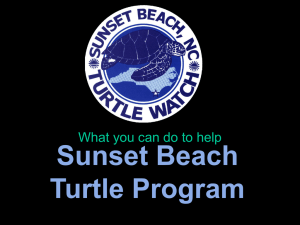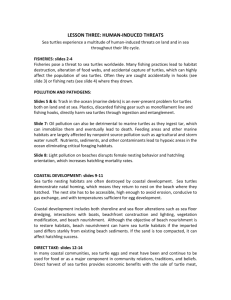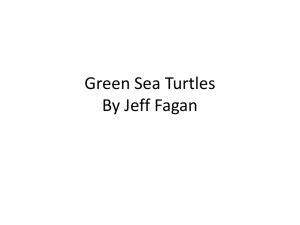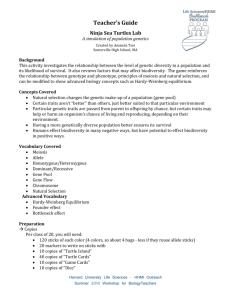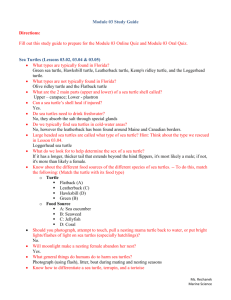Elizabeth Waters - Advanced Senior English
advertisement
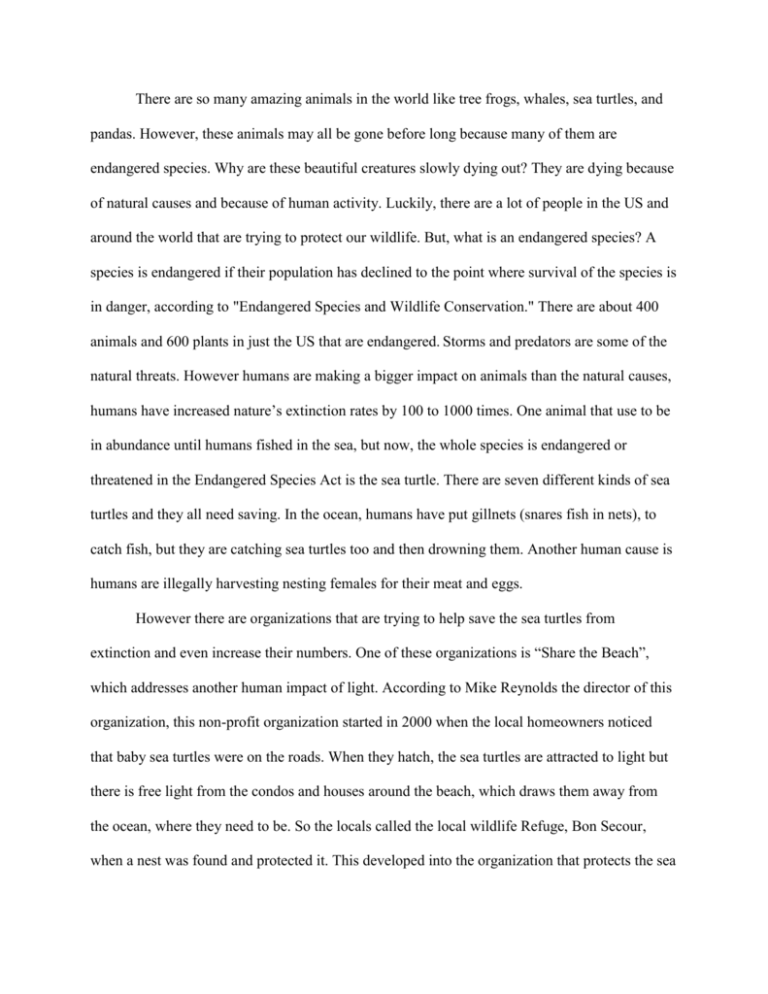
There are so many amazing animals in the world like tree frogs, whales, sea turtles, and pandas. However, these animals may all be gone before long because many of them are endangered species. Why are these beautiful creatures slowly dying out? They are dying because of natural causes and because of human activity. Luckily, there are a lot of people in the US and around the world that are trying to protect our wildlife. But, what is an endangered species? A species is endangered if their population has declined to the point where survival of the species is in danger, according to "Endangered Species and Wildlife Conservation." There are about 400 animals and 600 plants in just the US that are endangered. Storms and predators are some of the natural threats. However humans are making a bigger impact on animals than the natural causes, humans have increased nature’s extinction rates by 100 to 1000 times. One animal that use to be in abundance until humans fished in the sea, but now, the whole species is endangered or threatened in the Endangered Species Act is the sea turtle. There are seven different kinds of sea turtles and they all need saving. In the ocean, humans have put gillnets (snares fish in nets), to catch fish, but they are catching sea turtles too and then drowning them. Another human cause is humans are illegally harvesting nesting females for their meat and eggs. However there are organizations that are trying to help save the sea turtles from extinction and even increase their numbers. One of these organizations is “Share the Beach”, which addresses another human impact of light. According to Mike Reynolds the director of this organization, this non-profit organization started in 2000 when the local homeowners noticed that baby sea turtles were on the roads. When they hatch, the sea turtles are attracted to light but there is free light from the condos and houses around the beach, which draws them away from the ocean, where they need to be. So the locals called the local wildlife Refuge, Bon Secour, when a nest was found and protected it. This developed into the organization that protects the sea turtle nests and protect the hatchlings from artificial lighting. So the org. has people, walk down the beaches in Alabama in search for the nests so they can protect them from all dangers and do what they can to increase the survival of the eggs and baby sea turtle’s chance of making it to the ocean. For this organization they have different jobs to achieve their goals. The first objective is to monitor sea turtle nests and hatchlings on their coast. First, there are volunteers that walk along the beach starting in May (start of nesting season) until august in search for sea turtle tracks to determine if she laid eggs or not and where the nest is located. When the location of nest is found it is marked off and a protective screen is placed around the nesting area. This is to protect the nest from being trampled on by people and predators. Then the eggs are left for 55-75 days of incubation. After 55 days (July-October) the volunteers came back to the nest because hatching can happen any day now. A week before, the leader has to coordinate actions to lessen the effects of artificial light near the nest. The baby sea turtles hatch during the night and are guided by the moonlight to the ocean. But if there is other light, it can throw the hatchlings off course to ocean. A trench is also made from nest to the ocean to keep the sea turtles going the right way. This is how the program achieves their two objectives, to lessen “human-related sea turtle mortality, especially the effects of artificial light pollution, by assisting hatchlings to the Gulf of Mexico”. One major accomplishment is that over the years, Share the Beach has helped about 90,000 hatchlings to the water. Another is that last year, they helped relocated a majority of their sea turtle nests just before they hatched to a special facility in Florida when the beaches were too oily for the baby sea turtles. Then they could be released into the clean Atlantic Ocean. Last goal is to promote the conservation of sea turtles in Alabama through public outreach and education. We need to tell the public about these magnificent creatures so they know that they are close to extinction unless we do something about it. Share the Beach puts up signs on the beach and by nests about the sea turtles. You can help the sea turtles. To learn more about the share the beach and how to volunteer, go to alabamaseaturtles.com or call 1-866-SEA-TURTLE. Or you can donate to this worthy organization, all the money goes to the sea turtles, from the signs to alert people of sea turtles to vehicles to search the beaches for nests to the material to protect the nests like stakes and markers and signs. Any donation would help them significantly since it is a non-profit org. and donation is how they get most of their money. So, help save the sea turtles! In 2008, Seventy-eight loggerhead (Caretta caretta) nests and one Kemps Ridley were identified. is estimated that 3520 hatchling safely made it into the Gulf of Mexico. From 2003 – 2008 an estimated 17,390 hatchlings safely entered into the Gulf of Mexico. What you can do to help is volunteer for this program, “Share the Beach” (alabamaseaturtles.com), or other wildlife organizations by the ocean that help/protect sea turtles on the beach. You could be the nest searcher or a nest monitorer. If you do not live be the ocean or any where there is sea turtles, you can donate to the org. The “share the Beach” has a program called “Adopt-a-Nest” to help run the program. INTERVIEWER! Many of these species are in small or limited areas in the world, like pandas only in bamboo forest, that when something does disrupt their habitat Some disruptions to the environment can be both natural and human. Disease, natural climate (change in), habitat competition, and disasters/storms or nesting site, it could be fatal to the entire species. What humans have done to increase the rate at which species become extinct is killing/hunting (for meat, fur, and jewelry) species faster than they can reproduce, take the species’ habitat for human uses, introduce species to new diseases or predators, damaging the ecology, and global climate change. drift nets (gillnets that drift with the current), and longline fisheries Bon Secour National Wildlife Refuge. This refuge is a wildlife habitat located on the coast of Alabama. Congress established it in 1980 to serve habitat for non-game birds migrating south in the fall and north in the spring. But it has expanded to support/help other endangered animals in the region, like the Nine-banded armadillo, green tree frog, and corn snake. The refuge’s goal is “to conserve fish, wildlife and plants, which are listed as endangered or threatened species, to conserve an undisturbed beach/dune ecosystem which includes a diversity of fish and wildlife, and for the development, advancement, management, conservation and protection of fish and wildlife resources.” On their beaches, Bon Secour has nests from three kinds of sea turtles are green turtle, Loggerhead Turtle and Kemp’s Ridley Turtle. They focus on nesting sites. 1.) To monitor sea turtle nests and hatchlings on the Alabama Gulf coast 2.) To mitigate human-related sea turtle mortality, especially the effects of artificial lightpollution, by assisting hatchlings to the Gulf of Mexico through the presence of volunteers ALABAMA SEA TURTLE CONSERVATION MANUAL REVISED MAR 2008 4 3.) To promote the conservation of sea turtles in Alabama through public outreach and education These tracks, often called "crawls," can provide information about her species and size, problems that she may have encountered on the beach, and can help us to determine whether or not she deposited eggs.Protectve screen Relocation may be appropriate when the nest is found in one of the following conditions: ™ Near or below the mean high tide line ™ Within an approved beach renourishment project where relocation is mandated ™ Along a seawall or other manmade object that will cause unnatural erosion to the nest Sea turtle nests usually hatch after 55-75 days of incubation (JulyOctober). Monitoring typically begins once the nest has reached Day 55 of incubation. Nests may need to be monitored earlier than 55 days depending on seasonal temperatures. Some years, nest monitoring has begun at Day 50 of incubation since nests have hatched well before 55 days due to exceptionally dry, hot conditions. One week prior to Day 55 of incubation, your Team Leader will coordinate actions to mitigate the effects of artificial light near the nest, for example: ™ Distribute Share the Beach literature (magnets, door hangers, light plate stickers, brochures) to homes and condos near nests that are about to hatch and ask the homeowners or tenants to reduce or eliminate lighting that may affect sea turtles. ™ Contact Baldwin EMC and ask them to turn off street lights near the nest (they will need to know the pole #). ™ Set up tarp (silt fence) and dig trench at nest To report a sea turtle stranding, In 2001, volunteers and the U.S. Fish and Wildlife Service (USFWS) Daphne Ecological Services Field Office led an effort to establish a sea turtle monitoring program on private and public lands in Alabama. This effort was a response to widespread reports of sea turtle hatchlings that had become disoriented due to artificial lighting along State Highway 182 in the cities of Gulf Shores and Orange Beach. As a result, Share the Beach, a program that currently has more than 200 volunteers, was born. The program is supported by a partnership of state, federal, and local agencies, private citizens, and environmental organizations. P http://www.fws.gov/daphne/es/endangered_species.html http://www.fws.gov/endangered/about/index.html How to Become a Sea Turtle Volunteer Requirements A minimum of 1 month of volunteer service is required to participate in the program due to training and expenses. Unfortunately, this means that the program is not appropriate for short-term visitors to the area. However, there are other ways that you can support sea turtle conservation in Alabama such as our Adopt-A-Nest program. A minimum of 2 hours/week of volunteer service is required during the nest searching period of the season (MayAug) and/or 6 hours/week during the hatching period of the season (July-Oct). You must attend one of the sea turtle training sessions offered by your Team Leader. Description Share the Beach volunteers monitor sea turtle nests on the entire Alabama Gulf Coast from Dauphin Island to the Florida state line. If you're a morning person, you can volunteer to patrol the beach for sea turtle nests beginning at about 6am from May-August. If you're a night owl, then nest monitoring, or "nest sitting," may be just the job for you. Nest monitoring begins when the first nests hatch in July through the last nests in October and involves staying out on the beach late at night and experiencing first-hand one of the most incredible wildlife spectacles in nature, the loggerhead sea turtle's march to the sea. If you are unable to walk the beach, then we have volunteer opportunities in the areas of administration, web support, and public outreach. Bon Secour National Wildlife Refuge The Bon Secour NWR consists of 6,700 acres of wildlife habitat lying directly west of Gulf Shores, Alabama on the Fort Morgan peninsula of south Alabama. The refuge was established by congress in 1980 to serve habitat for non-game birds migrating south in the fall and north in the spring. The migration paths from Bon Secour lead south to lower Florida, the Caribbean, Mexico and Central America Goals of the refuge are to conserve fish, wildlife and plants, which are listed as endangered or threatened species, to conserve an undisturbed beach/dune eco csystem, which includes a diversity of fish and wildlife, and for the development, advancement, management, conservation and protection of fish and wildlife resources. The Refuge is home to the endangered Alabama beach mouse, which is associated with the sand dunes and sea oats. Refuge beaches serve as nesting sites for green, loggerhead, and Kemp's Ridley sea turtles. Habitats include beaches and sand dunes, scrub forest, fresh and saltwater marshes, fresh water swamps, and uplands. More than 400 species of birds have been identified and banded at the refuge during migratory seasons. The largest are usually ospreys and several species of herons. At the other extreme, seven species of hummingbirds have been identified. Mammals such as red fox, wild pig, coyotes, armadillos and others are also present
